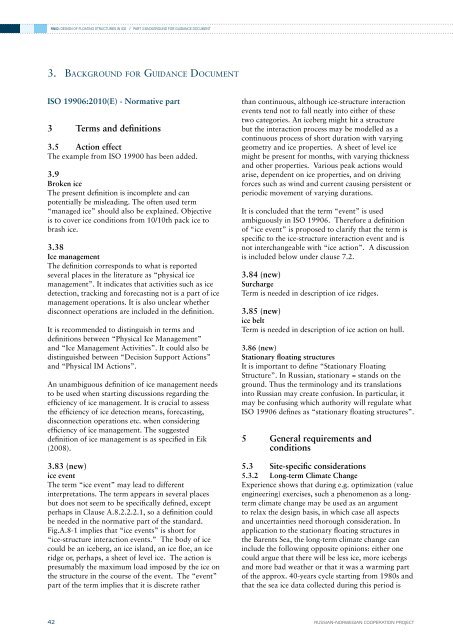phase 4 report - DNV
phase 4 report - DNV
phase 4 report - DNV
Create successful ePaper yourself
Turn your PDF publications into a flip-book with our unique Google optimized e-Paper software.
RN02: DESIGN OF FLOATING STRUCTURES IN ICE // PART 3 Background for Guidance Document3. Background for Guidance DocumentISO 19906:2010(E) - Normative part3 Terms and definitions3.5 Action effectThe example from ISO 19900 has been added.3.9Broken iceThe present definition is incomplete and canpotentially be misleading. The often used term“managed ice” should also be explained. Objectiveis to cover ice conditions from 10/10th pack ice tobrash ice.3.38Ice managementThe definition corresponds to what is <strong>report</strong>edseveral places in the literature as “physical icemanagement”. It indicates that activities such as icedetection, tracking and forecasting not is a part of icemanagement operations. It is also unclear whetherdisconnect operations are included in the definition.It is recommended to distinguish in terms anddefinitions between “Physical Ice Management”and “Ice Management Activities”. It could also bedistinguished between “Decision Support Actions”and “Physical IM Actions”.An unambiguous definition of ice management needsto be used when starting discussions regarding theefficiency of ice management. It is crucial to assessthe efficiency of ice detection means, forecasting,disconnection operations etc. when consideringefficiency of ice management. The suggesteddefinition of ice management is as specified in Eik(2008).3.83 (new)ice eventThe term “ice event” may lead to differentinterpretations. The term appears in several placesbut does not seem to be specifically defined, exceptperhaps in Clause A.8.2.2.2.1, so a definition couldbe needed in the normative part of the standard.Fig.A.8-1 implies that “ice events” is short for“ice-structure interaction events.” The body of icecould be an iceberg, an ice island, an ice floe, an iceridge or, perhaps, a sheet of level ice. The action ispresumably the maximum load imposed by the ice onthe structure in the course of the event. The “event”part of the term implies that it is discrete ratherthan continuous, although ice-structure interactionevents tend not to fall neatly into either of thesetwo categories. An iceberg might hit a structurebut the interaction process may be modelled as acontinuous process of short duration with varyinggeometry and ice properties. A sheet of level icemight be present for months, with varying thicknessand other properties. Various peak actions wouldarise, dependent on ice properties, and on drivingforces such as wind and current causing persistent orperiodic movement of varying durations.It is concluded that the term “event” is usedambiguously in ISO 19906. Therefore a definitionof “ice event” is proposed to clarify that the term isspecific to the ice-structure interaction event and isnot interchangeable with “ice action”. A discussionis included below under clause 7.2.3.84 (new)SurchargeTerm is needed in description of ice ridges.3.85 (new)ice beltTerm is needed in description of ice action on hull.3.86 (new)Stationary floating structuresIt is important to define “Stationary FloatingStructure”. In Russian, stationary = stands on theground. Thus the terminology and its translationsinto Russian may create confusion. In particular, itmay be confusing which authority will regulate whatISO 19906 defines as “stationary floating structures”.5 General requirements andconditions5.3 Site-specific considerations5.3.2 Long-term Climate ChangeExperience shows that during e.g. optimization (valueengineering) exercises, such a phenomenon as a longtermclimate change may be used as an argumentto relax the design basis, in which case all aspectsand uncertainties need thorough consideration. Inapplication to the stationary floating structures inthe Barents Sea, the long-term climate change caninclude the following opposite opinions: either onecould argue that there will be less ice, more icebergsand more bad weather or that it was a warming partof the approx. 40-years cycle starting from 1980s andthat the sea ice data collected during this period is42RUSSIAN–NORWEGIAN COOPERATION PROJECT






![Risk Based Pipeline Integrity Management [Compatibility Mode] - DNV](https://img.yumpu.com/50424229/1/190x146/risk-based-pipeline-integrity-management-compatibility-mode-dnv.jpg?quality=85)









